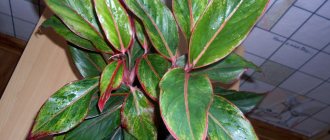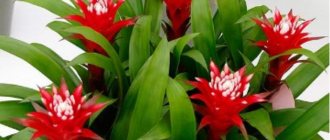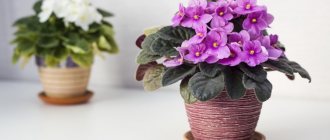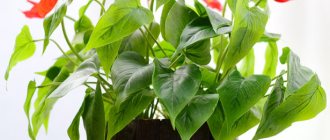Description
Perennial small succulent. An adult plant can be only 10 cm. Sometimes it grows up to half a meter; in an artificial environment it is very difficult to achieve active growth.
The root system is located on the surface and is very weak. The plant itself consists of highly branched shoots, the skin on the shoots is smooth. The shoots are slightly curved and rather thick. The color is rich green with an addition of pinkish or yellowish color. The shoots of most varieties are covered with a whitish, waxy coating. The number of faces is from four to six. Small protrusions stand out along the ribs.
Blooms in summer. Large buds develop at the base of the stapelia or at its crown. The flower is held on a separate elongated peduncle. The flowers are flattened, five-petaled or bell-shaped. They can be small - about 5 cm, and also large - up to 30 cm. The petals are dense, juicy, and form a fused funnel in the center. The flowers are completely or only their edges covered with glandular fibers. The color of the pile is white or faded pink. The colors of the flowers vary greatly - from lemon to burgundy.
The flowers are very unusual and catchy. The only drawback of the slipway is the sharp, unpleasant smell. It has been compared to the smell of rotten eggs, rotting meat or fish. The specific aroma is explained by the peculiarity of pollination. Only flies can do this. The stench attracts them. Seeds can ripen for more than a year.
general information
This plant, belonging to the Kutrov family, can be called strange and unusual. It is often called a cactus, although it is not one. Most species are naturally found in the semi-arid, arid regions of Southern and South-West Africa.
This is interesting! Stapelia, also called the “star of the order,” received its name from the Swedish naturalist Carl Linnaeus, who in 1737 named the succulent in honor of the Dutch physician Bodues Van Stapel.
Most often, the slipway grows as a bush, the height can vary from 10 cm to 0.5-0.6 m. It has a large number of succulent, tetrahedral stems, in which the plant stores moisture for the “black” dry period. At the base, the stems begin to branch, the ribs are covered with large, non-sharp teeth, which make the slipway look like cacti.
The shoots of the slipway are green, bluish in color, sometimes they have a reddish-violet tint in the sun, the lateral shoots are spread on the ground. The succulent has no foliage.
The flower of the stapelia is pubescent, can be paired or single, located on a bent peduncle, the size of which varies from 5 to 30 cm. The flowers are in most cases at the base of the shoots, and not at the ends, and have a very exotic shape, reminiscent of a starfish.
From the description of the slipway, it becomes clear why flower growers are showing interest in it, obtaining more and more spectacular varieties through selection. And even the fetid amber that the succulent exudes is not able to scare off true fans.
This is interesting! Goethe, who first saw stapelias in Holland, in the botanical garden of Leiden University, called them “the most beautiful, most monstrous flowers.” The British aptly named the aroma of these succulents “bad-fish”, translated as rotten fish.
Biologists quickly identified the reason why the flowers of the plant smell so bad. The thing is that they are pollinated by carrion flies, which, like bees to honey, flock to the aroma of rotting.
Known varieties
The genus includes more than 50 species. The most decorative and interesting species are adapted for home cultivation.
- Large-flowered. The shoots are green, with four edges. Branching begins from the very base. Closer to summer, an elongated peduncle forms in the lower part of the slipway. He carries a flower that looks like a starfish. The flower is quite large - in some cases it reaches 25 cm. The color is often burgundy or purple, the petals are covered with long silvery hair. It does not bloom for long - no more than five days. Popular due to its mild scent.
- Motley. The stems are bright and fleshy. The shape of the bush is close to a perfect circle. The ribs are smoothed, with curved teeth. Miniature variety - rarely larger than 10 cm. Blooms in the summer months. The flowers are variegated, bright up to 8 cm. The color is cream or yellowish with prominent burgundy or brownish spots. The corolla is flattened, with a protruding ring framing triangular petals. An unpretentious variety with a strong fetid odor.
- Star-shaped. Stems are tetrahedral. Compact plant up to 20 cm. The skin of the stems is smooth with faded purple or pinkish stains. The teeth are very small. Flowers are formed in the lower part, often collected in small groups of three. Pedicels are elongated and thin. The star-shaped corolla is relatively small - up to 8 cm. Villi are present only on the sides, the rest of the surface of the flower is smooth, glossy, slightly bumpy. The most common colors are yellow, red and orange.
- Gigantic. The shoots are long, succulent with pronounced longitudinal notches. It is distinguished by the largest flowers up to 35 cm. The flowers are pubescent, five-petaled. The color is predominantly yellowish-cream with thin short burgundy stripes. The tips of the petals are elongated, narrow, sometimes spirally twisted. The smell is very pungent, reminiscent of rotten meat.
- Golden purple. Compact plant up to 10 cm. The buds are formed in groups, collected at the top of the stem. The flowers are small - their size rarely exceeds 4 cm. They look like flat starfish. The surface is yellowish or light green, the center is a contrasting purple or white. Pubescence is predominantly in the center. The only variety with a pleasant but weak odor.
The flowering of the slipway is short-lived. Flowers last only a few days. By adjusting the care you can achieve flowering at any time of the year. When the buds have opened, they try not to disturb it - they exclude drafts and do not rearrange it. Any manipulations are kept to a minimum. Afterwards, they organize a short rest - lower the temperature, reduce watering and reduce the length of daylight hours. The crop perceives a subsequent increase in daylight hours as a signal for flowering.
Types of slipway with photos and names
Stapelia asterias
This low-growing plant reaches only 20 centimeters in height. The stems are most often colored green, but can also be light red, and have small teeth on their blunt edges. On the surface of the brown-red flowers there are thin stripes of yellow color, as well as pale pink thick hairs. The flowers are on long stalks at the base of young shoots. This species has a variety - stapelia shiny: it does not have yellow stripes on the surface of the flowers.
Giant slipway (Stapelia gigantea)
This succulent is a perennial plant with powerful, erect stems reaching 20 centimeters in height and 3 centimeters in diameter. The shoots have blunt edges and a small number of small teeth. The flowers are very large, they can reach about 35 centimeters in diameter. They are located on long stalks and have elongated, pointed, slightly bent yellowish triangular petals, on their surface there are thick red hairs, and along the edge there are long white fibers. The smell of such flowers is not as unpleasant as that of other types of slipway.
Stapelia variegata (Stapelia variegata)
The height of such a low-growing plant is only 10 centimeters. The stems are most often green, but they are also pale red, with denticles on their blunt edges. One or up to 5 flowers can be placed at the base of young stems. The yellow petals have an ovoid shape, pointed at the tips. Their outer part is smooth, but on the inside they have a wrinkled surface with asymmetrical spots or dark brown stripes. Flowering occurs in summer.
Stapelia glanduliflora
The height of this perennial is about 15 centimeters. The thickness of the straight stems is about 30 mm; they have wing-shaped edges, which are covered with sparse small denticles. The bush blooms with 1–3 flowers on long stalks; the yellow-green petals have a triangular, pointed shape, with pinkish spots and stripes on their surface. The petals are slightly bent at the edges and have long white hairs, and their surface is strewn with a large number of club-shaped colorless hairs.
Stapelia flavo-purpurea
The height of the bush is about 10 centimeters. The color of the stems is usually green, but can also be purple; they have blunt edges on which the cloves are located. At the tops of young stems, 1–3 flowers bloom; their petals are ovoid, pointed and triangular in shape, their edges are strongly curved. The outside of the flower is yellowish, bare and smooth, and the inside is yellow-golden (sometimes burgundy) and wrinkled. This flower has a rather pleasant waxy smell.
Stapelia grandiflora
This perennial has tetrahedral stems, and on the edges there are sparse curved teeth. The large flowers have lanceolate-shaped petals, the outside is green-blue, the inside is burgundy, and there are tufts of gray hairs on their surface. The petals are curved along the edge, and they have pubescence in the form of cilia. Flowering occurs in summer. The smell of the flowers is similar to the aroma of rotting meat.
If it doesn't bloom
Quite a common problem. There may be several reasons.
- Big pot. Stapelia blooms best in a slightly cramped pot. In a large amount of substrate, it begins to intensively grow shoots.
- No rest period. The flower buds of the slipway are laid during hibernation. If at this time it is kept warm, flowering does not occur.
- Young specimen. Young stapelias rarely bloom. They need to mature. Flowering age varies among different varieties. On average, slipway blooms in the third or fourth year.
To achieve flowering, remove old shoots and replant in a smaller pot. In winter, be sure to organize a rest - maintain the temperature at 12-15˚C, reduce the frequency of watering to one to three times a month. After the buds form, do not disturb the plant.
About the flowering of slipway
This period occurs in the summer, one “wave” lasts about 2 weeks. A viable slipway, producing young shoots, overwintering in cool conditions, blooms every year, 2–3 times per season.
It is important! The flower may drop its buds and flowers if the pot is moved to another location or rotated. During other periods, flower growers advise turning the container so that the stems grow evenly, without tilting, and the entire succulent receives enough light.
But often flower growers do not wait for the luxurious “fragrant” flowering of the African beauty. What's wrong and how to make the slipway bloom? In fact, there are many reasons why a succulent does not bloom:
- winter peace in warmth;
- lack of light;
- excessive, frequent watering;
- improper application of fertilizers: untimely, scanty or, on the contrary, too abundant, use of inappropriate fertilizers.
In order for the flower to bloom at the right time, you should pay attention to the following care rules:
- it is important to adhere to the recommended watering regime: moisten the soil only when it is completely dry; in the fall - once a month, December - January, it is advisable not to water at all;
- slipways overwintering in warm conditions do not bloom, so it is in the interests of the gardener to provide suitable conditions for the pet;
- a flower overfed with nitrogen will begin to grow intensively, which will not benefit it and will not allow it to bloom in the summer;
- the soil must contain sand;
- the plant must receive enough light.
If you provide the flower with suitable conditions, it will bloom long and profusely. But this process is accompanied by a kind of amber - putrefactive and unpleasant. The scents of flowers vary depending on the variety, but most often resemble the smell of rotten meat. The exception is the golden-purple stapelia, which smells like wax.
Flower growers rejoice not only in the luxurious flowering of the succulent, but also in the fact that this happens in the summer, when the “fragrant” flower can be placed on the balcony. Stapelia will attract pollinating flies, which will flock to the enchanting smell.
Basic care
Growing slipway does not require special skills. But a number of requirements for microclimate and care must be adhered to.
- Lighting. Stapelia loves bright light, but the sun causes burns. It can only be placed in the sun in spring or autumn. It is better to place it on a western or eastern window. On hot days they provide shade. After being kept in a shaded place, they are gradually accustomed to light.
- Temperature. The plant is thermophilic. The optimal summer temperature for slipway is 22-26˚C. In autumn it feels good at a temperature of about 15˚C. In winter they keep it cool - 12-14˚С. No further drop in temperature is allowed.
- Watering. In warm weather, throughout the growing season, the slipway is watered as the soil dries. In summer, watering is regular and quite abundant, in autumn - moderate and infrequent, in winter - minimal. The need for watering in winter is determined by the condition of the plant. If the leaves of the stapelia begin to wrinkle, it is time to water. Prolonged drought has a negative effect - the roots begin to gradually die.
- Humidity. The level of humidity in the room does not play any role. This is a succulent plant that stores enough moisture. There is no need for spraying.
- Feeding. It is recommended to use special fertilizers for cacti. Additionally, you can feed with potassium fertilizers. Potassium - strengthens the immunity of the slipway, making it more resistant to diseases.
- The soil. Use sandy soil. The simplest composition is a mixture of turf and soil. You can use ready-made soils for succulents, but you must add crushed coal to them.
- Transfer. Held once a year. For adult plants, rarer transplants are acceptable. The pot is wide and shallow. After the “moving”, a temporary lack of watering, moderate lighting and temperature are necessary.
Stapelia juice contains toxic substances. If they come into contact with the skin, they may cause irritation. Therefore, it is better to carry out all replanting and pruning work with rubber gloves.
Planting and care at home
Stapelia is a rather fragile plant, so replanting must be done very carefully. In order not to break the roots, they use the transshipment method while preserving the earthen clod. The best time for transplantation is spring. The procedure is carried out every 1-3 years. In this case, dry and old shoots can be removed, and a large bush can be divided into several parts.
The pot should be shallow, but wide enough. A third of its height is filled with drainage material (expanded clay, pebbles, fragments of red brick). The free space between the roots and walls is filled with soil with a neutral or slightly acidic reaction. The soil should contain a large amount of river sand, as well as turf soil and a handful of charcoal. Immediately after planting, the slipway must be placed in a place with diffused lighting. Avoid watering for a week. When the flower adapts to the new soil, the soil begins to be moistened with caution.
Caring for slipways at home is not difficult. If the location is correctly selected, the flower does not need excessive attention. If you overprotect it, water it often and move it from place to place, it can get sick.
Lighting. Stapelia needs bright, intense lighting. It can be placed on southern, western and eastern window sills, but in summer it can be shaded from the midday sun. Excess light and exposure to direct sunlight causes burns. They appear as dry brown spots on the leaves. Even reddening of the stems is the first signal of a problem. In winter, northern rooms may need additional lighting.
Temperature. In spring and summer, the optimal air temperature is +22…+26°C. You can place the flower on the balcony, but carefully protect it from drafts. In November-February it is necessary to provide the plant with a period of rest. At this time, it should be kept in a well-lit, cool room (+14...+16°C). Cold temperatures below +12°C are not allowed.
Humidity. Like any succulent, slipway tolerates dry air well. It does not need additional spraying. Infrequent bathing in a warm shower is allowed, but should be avoided during the flowering period. When swimming, you need to protect the soil from flooding.
Watering. Stapelia needs moderate watering so that the soil dries out by half between irrigations. In autumn, as the temperature drops, watering is done less frequently. In winter, it is enough to pour how many tablespoons into the pot to slightly moisten the soil.
Fertilizer. In April-September, the slipways are fertilized twice a month with mineral compounds for cacti. The fertilizer solution is poured into the soil at a short distance from the roots. The complex must contain a sufficient amount of potassium, as it increases the plant’s immunity. In the fall, fertilizing is stopped completely.
Reproduction methods
Propagation of slipway by cuttings, seeds and dividing the bush is practiced. All methods are quite effective.
- Seeds. The seeds take a long time to ripen - at least a year. They sprout quickly. Sow the seeds in a light substrate with a predominance of sand, moisten it, and cover it with film. The first shoots appear within a month. When the seedlings grow up, they can be planted in separate small pots. Subsequent transplants as they grow using the transshipment method. They work very carefully, trying not to injure the delicate root system.
- By cuttings. It is better to take cuttings from old shoots - they take root more easily. During the day, the cuttings are withered and then planted. A mixture of peat chips and sand is used as a substrate. There is no need to cover anything. Maintains stable humidity. The roots appear quite quickly. After complete rooting, the seedlings are planted in separate pots.
- Dividing the bush. At the same time as replanting, you can divide the bush. Divide carefully, trying not to break or damage the roots. Each part is planted in a separate container.
It is recommended to turn the pot regularly. If the lighting is uneven, the slipway may turn out to be one-sided. During the period of bud formation and flowering, the slipway is not touched.
How does stapelia reproduce?
Reproduction of slipway is carried out by cuttings and seed method. Planting with shoots is the most effective method, since the plant actively grows green mass. It takes about a year for the seed fruit to ripen. At the same time, planting seeds does not guarantee the preservation of the varietal qualities of future seedlings.
Slipway shoots
Germination of seeds
Scented flowers are usually pollinated by flies, which fly to the pungent smell.
The seeds ripen in the fruits, which can then be used as planting material for propagation of stapelia.
The seed is sown in a sandy mixture, the pots should be flat. The crops are irrigated with a spray bottle and covered with film.
Every day the greenhouse is opened for an hour for ventilation. After about 20-30 days, seedlings will appear; after a few weeks they are transferred to a larger container, planted in a substrate for succulents.
You should know! When propagated by seeds, the plant may lose its varietal qualities. In the future, you may not be able to wait for flowering; the shape of the bush will be different.
Rooting cuttings
Stems 5-8 cm long are cut from adult bushes with a sharp knife and left to dry in the air.
The sections are treated with crushed charcoal, then the shoots are planted in the substrate. The mixture should consist mainly of sand, to which a little peat is added.
After a few weeks, properly planted cuttings will take root, after which they are planted in permanent pots with more nutritious soil.
Rooting cuttings of slipway
Diseases and pests
Stapelia is considered a resilient succulent - problems are extremely rare. Sometimes it is affected by pests; with regular waterlogging, you can encounter a disease such as rot. All main problems, their solutions and treatment are described in detail in the table.
Table - Problems of growing slipway
| Problem | Signs | Elimination |
| Mealybug | White, cotton-like formations | Repeatedly treated with Fitoverm or Actellik. |
| Spider mite | — Growth slowdown; - light dots on shoots; - thin, small cobweb | — Increases humidity in the room; - treated with “Aktara” or “Aktellik” products |
| Root rot | — Softening and falling of shoots; - rotting of roots | - Water with Previkur; - transplanted into fresh and sterile soil; - cuttings are carried out in case of death of the slipway |
| Light, elongated shoots | — Lack of light; - lack of nutrition; - potassium deficiency | — Feed with a preparation containing potassium; - adjust the conditions of care |
| No flowering | — Spacious pot; - young age; - wintering in warmth | Eliminate care errors |
| Brownish spots on stems | Sunburn | Shade in hot weather |
Stapelia can be called an ideal plant for offices and busy people. If the smell from the flower seems completely unpleasant to you, then during flowering the plant can be moved to the balcony.
What is good about slipway
The home slipway is distinguished by its completely non-standard and spectacular appearance. Thus, the unusual shape is determined by the following characteristics of the plant:
Thorns. Stapelia belongs to succulents - plants that have special tissue that can retain liquid inside. This ability is characteristic of all cacti and gives the flower a special feature - teeth along the entire stem.
Terry flowers. The “juice” of slipways is the original flowers, which have not only the eye-catching shape of a starfish, but also the interesting texture of the petals, covered with many small fibers.
Lots of stems. Often the number of stems growing from a powerful root system reaches several dozen. Their bizarre shape, reminiscent of fangs, is also interesting: a wide base and a narrow top.
Rich colors. Stapelia will become a bright accent in the room, because it has a fairly rich color palette: light green stems and red-violet flowers.
Thanks to these advantages, slipway is considered one of the most popular indoor plants. However, it also has a significant drawback that should be taken into account when planting.
Growing stapelia from seeds
Stopelia seeds photo What the Stopelia fruits look like
To collect seeds, it is necessary to wait for the fruit to ripen for more than a year. Seeds are sown in bowls in light sandy soil, waiting for germination within 3-4 weeks. Stapelia grows slowly, so you need to be patient and try not to overdo it with watering: the ground should be only slightly damp, but not wet.
Slipway seedlings 4 months old photo
The grown seedlings are planted in separate cups, using soil as for cuttings. After a year, using the transshipment method, they are transplanted into larger pots.











